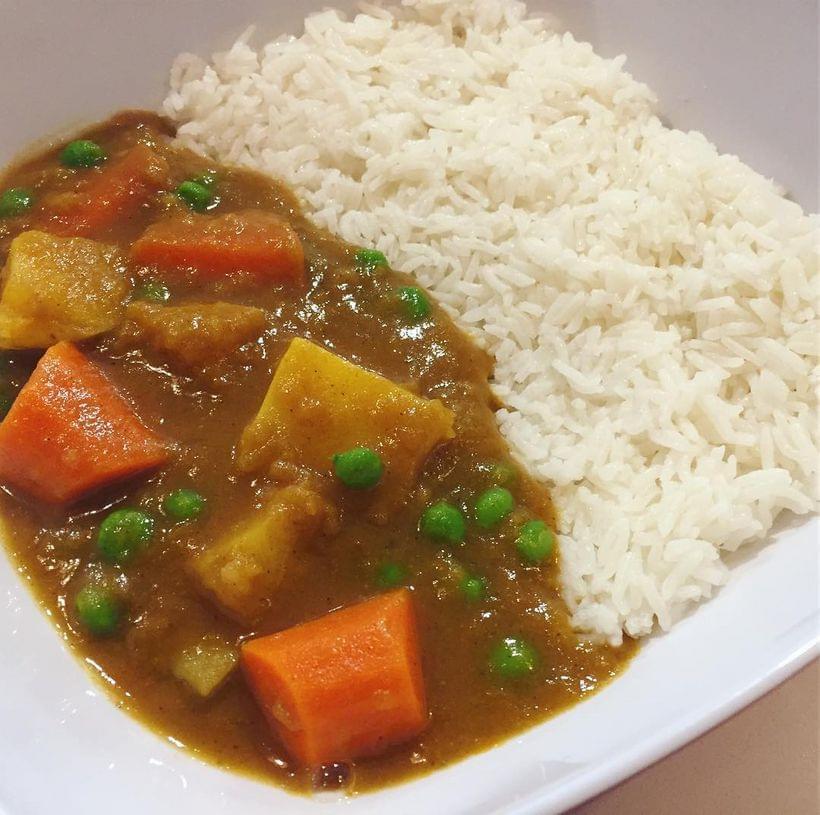Curry Rice

For years now, I’ve been on a quest for the ultimate from-scratch curry rice recipe. No store-bought roux blocks; homemade stock, hand-toasted and ground spice blends. This is where I’ve landed thus far.
Recently popularized by coffee shop employment simulator Persona 5, Japanese curry rice (カレー, pronounced karē) is, in my opinion, the pinnacle of “fusion” cuisine: a Japanese dish, using French cooking techniques, based on Indian cuisine that arrived in Japan by way of England. What’s really fascina—
Wait, no, shut up; why is there Marmite in this?
Okay. Look, I hear you. For those of you unfamiliar with Vegemite and/or Marmite: it’s yeast extract—leftover brewers’ yeast, originally—and vegetables, boiled down to the look, consistency, and flavor of substances I have encountered on the underside of my motorcycle.
Now, I’m a dude that doesn’t shy away from the funkiest of cheeses. I find some kimchi of indeterminate age under a couch cushion somewhere, I’m gonna sneak a taste. I drink Moxie. You offer me a smear of Marmite on toast— I’m good, actually. Just, like, some peanut butter for me, I think, probably, on account of how that is a thing that tastes good instead of weird and bad.
Here’s the thing, thou— actually, hold on, I’ll do a whole article about it.
Here’s the thing, though: umami. Yeast extract contains an absurd amount of glutamate—a teaspoon’s worth isn’t going to change the flavor in a huge way, but it is gonna boost the umami of the dish in a huge way. I can’t claim to know what sort of chemical alchemy takes place, but I know what results from adding a teaspoon of nasty ol’ extract to the hot oil I’m using to soften my aromatics: after a few moments, the kitchen is filled with a smell that’s equal parts rich, sweet, and inexplicable. It isn’t just “umami,” though that meaty, savory flavor is there in spades. There’s something more; there’s a fullness to it, akin to something I’d struggled to describe during my early attempts at curry rice. The final results always came up lacking, in a way that words like “richess” didn’t quite capture.
There is a word for it, as it turns out: “kokumi.”
Kokumi (from “koku,” meaning “rich,” and “mi,” meaning “essence”) was coined a few years ago by researchers at Ajinomoto—the group responsible for the synthesis of MSG. It’s a combination of elements: the complexity of flavors, the way those flavors linger on the palate, and mouthfeel.
The flavors seemed amplified and balanced, as if the volume control and had been turned up and an equalizer turned on. They also seemed somehow to cling to my mouth—a tactile feeling—and to last longer before fading away.
—‘Kokumi’ Experience Report by Dr. Harold McGee
There’s a lot going on in curry rice. In the best case, all those flavors comes through in concert; rich and complex. In the worst case, it all comes through at once; a dull, muddied flavor. I hadn’t heard about any of this the first time I tried Marmite out in this recipe, strictly looking to boost the umami. The “equalizer” effect was immediately noticeable. The flavors seemed to stand out more; the curry was more curry somehow. I still can’t claim to understand the science involved, but come to find out:
…yeast extract has been commercialized and used for the enrichment of kokumi in the food industry.
—Food Proteins and Peptides: Chemistry, Functionality, Interactions, and Commercialization
How ’bout that.
This recipe takes a long time
If you brown the onions and shallots too far, or too quickly, you’ll get bitterness. If you brown the roux too far, or too quickly, you’ll get bitterness. A long simmer concentrates flavors. It’s better after a night in the fridge.
So, in the end, I’ve got one big piece of advice for this recipe:

Ingredients
-
20 G Ginger
-
20 G Garlic
-
1 tsp. Marmite
Optional -
300 G Shallots
-
150 G Onions
-
A pinch White sugar
-
1 Quart Utility stock
-
1 Tbsp. Tonkatsu sauce
-
11/2 Tbsp. Tomato paste
-
11/2 tsp. Cocoa powder
-
2 tsp. Honey
-
1 Bay Leaf
-
3 Tbsp Unsalted butter
-
3 Tbsp All-purpose flour
-
3 Tbsp Curry powder
-
4 Yukon gold potatoes, diced
-
6 Carrots, oblique cut
-
1 C. Green peas, frozen
Instructions
In a large, heavy-bottomed pot (I use an enameled cast icon dutch oven), over medium heat, heat about a tablespoon of neutral oil until just shimmering. Add ginger and garlic, and cook over medium-low heat until fragrant; only a few minutes. Add Marmite, mix, and cook for another minute or so.
Add shallots, onions, a pinch of white sugar, and a few more tablespoons of oil. Stir and cook, covered, for about fifteen minutes.
Carefully remove the lid (watch out for steam). The onions and shallots should have released most of their liquid; increase heat to medium-high, and reduce. As liquid evaporates, the aromatics should start to brown slowly; stir frequently, scraping fond from the bottom of the pot—add a spash of water or stock to help with this process, but don’t oversaturate. Continue stirring, scraping, and adding liquid in small increments; this part takes a long time.
Once shallots, onions, garlic, and ginger are a uniform golden brown, add stock, tonkotsu sauce, cocoa powder, honey, and a bay leaf. Reduce heat to low-medium and simmer, uncovered, for about an hour.
Remove bay leaf and blend until smooth using an immersion blender, if desired.
Using a medium-sized saucepan, melt butter over medium heat until foaming. Stir in flour and cook, stirring, until roux reaches a rich chestnut brown. This should take at least 15–20 minutes; don’t rush it. Remove from heat, add curry powder and whisk to combine.
Over low heat, add a ladel full of the stock mixture into the roux and whisk vigorously to combine—it should form a thick paste right away. Whisk this into the stock.
Add carrots and potatoes and cook until fork tender; the curry will thicken in the meantime. Add frozen peas, cook just until fully thawed—a few minutes—and serve.